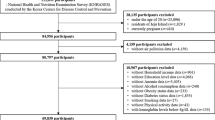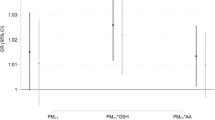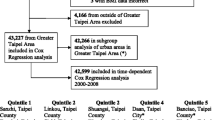Abstract
Previous studies have suggested that exposure to air pollutants may be associated with specific blood indicators or anemia in certain populations. However, there is insufficient epidemiological data and prospective evidence to evaluate the relationship between environmental air pollution and specific types of anemia. We conducted a large-scale prospective cohort study based on the UK Biobank. Annual average concentrations of NO2, PM2.5, PM2.5-10, and PM10 were obtained from the ESCAPE study using the Land Use Regression (LUR) model. The association between atmospheric pollutants and different types of anemia was investigated using the Cox proportional hazards model. Furthermore, restricted cubic splines were used to explore exposure-response relationships for positive associations, followed by stratification and effect modification analyses by gender and age. After adjusting for demographic characteristics, 3-4 of the four types of air pollution were significantly associated with an increased risk of iron deficiency, vitamin B12 deficiency and folate deficiency anemia, while there was no significant association with other defined types of anemia. After full adjustment, we estimated that the hazard ratios (HRs) of iron deficiency anemia associated with each 10 μg/m3 increase in NO2, PM2.5, and PM10 were 1.04 (95%CI: 1.02, 1.07), 2.00 (95%CI: 1.71, 2.33), and 1.10 (95%CI: 1.02, 1.20) respectively. The HRs of folate deficiency anemia with each 10 μg/m3 increase in NO2, PM2.5, PM2.5-10, and PM10 were 1.25 (95%CI: 1.12, 1.40), 4.61 (95%CI: 2.03, 10.47), 2.81 (95%CI: 1.11, 7.08), and 1.99 (95%CI: 1.25, 3.15) respectively. For vitamin B12 deficiency anemia, no significant association with atmospheric pollution was found. Additionally, we estimated almost linear exposure-response curves between air pollution and anemia, and interaction analyses suggested that gender and age did not modify the association between air pollution and anemia. Our research provided reliable evidence for the association between long-term exposure to PM10, PM2.5, PM2.5-10, NO2, and several types of anemia. NO2, PM2.5, and PM10 significantly increased the risk of iron deficiency anemia and folate deficiency anemia. Additionally, we found that the smaller the PM diameter, the higher the risk, and folate deficiency anemia was more susceptible to air pollution than iron deficiency anemia. No association was observed between the four types of air pollution and hemolytic anemia, aplastic anemia, and other types of anemia. Although the mechanisms are not well understood, we emphasize the need to limit the levels of PM and NO2 in the environment to reduce the potential impact of air pollution on folate and iron deficiency anemia.



Similar content being viewed by others
Abbreviations
- BMI:
-
body mass index
- CI:
-
confidence interval
- ESCAPE:
-
European Study of Cohorts for Air Pollution Effects
- Hb:
-
hemoglobin
- HR:
-
Hazard Ratio
- HULIS:
-
Humic-Like Substances
- ICD-10:
-
International Statistical Classification of Diseases and Related Health Problems, 10th Revision
- IL-6:
-
Interleukin-6
- IPAQ:
-
International Physical Activity Questionnaire
- LUR:
-
Land Use Regression
- NO2:
-
nitrogen dioxide
- PM10:
-
inhalable particulate matter
- PM2.5:
-
fine particulate matter
- PM2.5-10:
-
coarse particulate matter
- RCS:
-
restricted cubic spline
References
Atti AR, Palmer K, Volpato S, Zuliani G, Winblad B, Fratiglioni L (2006) Anaemia increases the risk of dementia in cognitively intact elderly. Neurobiol Aging 27(2):278–284. https://doi.org/10.1016/j.neurobiolaging.2005.02.007
Bárány P (2001) Inflammation, serum C-reactive protein, and erythropoietin resistance. Nephrol Dial Transpl 16(2):224–227. https://doi.org/10.1093/ndt/16.2.224
Barbosa SM, Farhat SC, Martins LC, Pereira LA, Saldiva PH, Zanobetti A, Braga AL (2015) Air pollution and children’s health: sickle cell disease. Cad Saude Publica 31(2):265–275. https://doi.org/10.1590/0102-311x00013214
Beard CM, Kokmen E, O’Brien PC, Anía BJ, Melton LJ 3rd (1997) Risk of Alzheimer’s disease among elderly patients with anemia: population-based investigations in Olmsted County, Minnesota. Ann Epidemiol 7(3):219–224. https://doi.org/10.1016/s1047-2797(97)00015-x
Beelen R, Hoek G, Vienneau D, Eeftens M, Dimakopoulou K, Pedeli X, et al (2013) Development of NO2 and NOx land use regression models for estimating air pollution exposure in 36 study areas in Europe – The ESCAPE project. Atmospheric Environ 72:10–23. https://doi.org/10.1016/j.atmosenv.2013.02.037
Brook RD, Rajagopalan S, Pope CA 3rd, Brook JR, Bhatnagar A, Diez-Roux AV, Holguin F, Hong Y, Luepker RV, Mittleman MA, Peters A, Siscovick D, Smith SC Jr., Whitsel L, Kaufman JD (2010) Particulate matter air pollution and cardiovascular disease: an update to the scientific statement from the American Heart Association. Circulation 121(21):2331–2378. https://doi.org/10.1161/CIR.0b013e3181dbece1
Chaparro CM, Suchdev PS (2019) Anemia epidemiology, pathophysiology, and etiology in low- and middle-income countries. Ann N Y Acad Sci 1450(1):15–31. https://doi.org/10.1111/nyas.14092
Chen C, Whitsel EA, Espeland MA, Snetselaar L, Hayden KM, Lamichhane AP, Serre ML, Vizuete W, Kaufman JD, Wang X, Chui HC, D’Alton ME, Chen JC, Kahe K (2022) B vitamin intakes modify the association between particulate air pollutants and incidence of all-cause dementia: findings from the women’s Health Initiative Memory Study. Alzheimers Dement 18(11):2188–2198. https://doi.org/10.1002/alz.12515
Czechowski F, Golonka I, Jezierski A (2004) Organic Matter transformation in the environment investigated by quantitative electron paramagnetic resonance (EPR) spectroscopy: studies on lignins. Spectrochim Acta Mol Biomol Spectrosc 60(6):1387–1394. https://doi.org/10.1016/j.saa.2003.10.037
D’Angelo G (2013) Role of hepcidin in the pathophysiology and diagnosis of anemia. Blood Res 48(1):10–15. https://doi.org/10.5045/br.2013.48.1.10
Dabass A, Talbott EO, Venkat A, Rager J, Marsh GM, Sharma RK, Holguin F (2016) Association of exposure to particulate matter (PM2.5) air pollution and biomarkers of cardiovascular disease risk in adult NHANES participants (2001–2008). Int J Hyg Environ Health 219(3):301–310. https://doi.org/10.1016/j.ijheh.2015.12.002
Das P, Chatterjee P (2015) Assessment of hematological profiles of adult male athletes from two different air pollutant zones of West Bengal, India. Environ Sci Pollut Res Int 22(1):343–349. https://doi.org/10.1007/s11356-014-3314-9
Denny SD, Kuchibhatla MN, Cohen HJ (2006) Impact of anemia on mortality, cognition, and function in community-dwelling elderly. Am J Med 119(4):327–334. https://doi.org/10.1016/j.amjmed.2005.08.027
Dolan J, Bajekal D (1995) Measuring disadvantage: changes in the underprivileged area, Townsend, and Carstairs scores 1981-91. Journal of Epidemiology & Community Health
Eeftens M, Beelen R, de Hoogh K, Bellander T, Cesaroni G, Cirach M, Declercq C, Dėdelė A, Dons E, de Nazelle A, Dimakopoulou K, Eriksen K, Falq G, Fischer P, Galassi C, Gražulevičienė R, Heinrich J, Hoffmann B, Jerrett M, Keidel D, Korek M, Lanki T, Lindley S, Madsen C, Mölter A, Nádor G, Nieuwenhuijsen M, Nonnemacher M, Pedeli X, Raaschou-Nielsen O, Patelarou E, Quass U, Ranzi A, Schindler C, Stempfelet M, Stephanou E, Sugiri D, Tsai MY, Yli-Tuomi T, Varró MJ, Vienneau D, Klot S, Wolf K, Brunekreef B, Hoek G (2012) Development of Land Use Regression models for PM(2.5), PM(2.5) absorbance, PM(10) and PM(coarse) in 20 European study areas; results of the ESCAPE project. Environ Sci Technol 46(20):11195–11205. https://doi.org/10.1021/es301948k
Elbarbary M, Honda T, Morgan G, Guo Y, Guo Y, Kowal P, Negin J (2020) Ambient Air Pollution Exposure Association with anaemia prevalence and haemoglobin levels in Chinese older adults. Int J Environ Res Public Health 17(9). https://doi.org/10.3390/ijerph17093209
EPA US (2019) Integrated science assessment (ISA) for particulatematter (final report, Dec 2019). EPA Report, Washington, DC, Report No.: EPA/600/R-19/188
Erdogan S, Baysal A, Akba O, Hamamci C (2007) Interaction of metals with Humic Acid isolated from oxidized coal. Pol J Environ Stud 16 (5)
Ezekowitz JA, McAlister FA, Armstrong PW (2003) Anemia is common in heart failure and is associated with poor outcomes: insights from a cohort of 12 065 patients with new-onset heart failure. Circulation 107(2):223–225. https://doi.org/10.1161/01.cir.0000052622.51963.fc
Ferrucci L, Balducci L (2008) Anemia of aging: the role of chronic inflammation and cancer. Semin Hematol 45(4):242–249. https://doi.org/10.1053/j.seminhematol.2008.06.001
Ganz T (2019) Anemia of inflammation. N Engl J Med 381(12):1148–1157. https://doi.org/10.1056/NEJMra1804281
Gaskins AJ, Mínguez-Alarcón L, Fong KC, Abu Awad Y, Di Q, Chavarro JE, Ford JB, Coull BA, Schwartz J, Kloog I, Attaman J, Hauser R, Laden F (2019) Supplemental Folate and the Relationship between Traffic-Related Air Pollution and Livebirth among women undergoing assisted Reproduction. Am J Epidemiol 188(9):1595–1604. https://doi.org/10.1093/aje/kwz151
Gauthier J, Wu QV, Gooley TA (2020) Cubic splines to model relationships between continuous variables and outcomes: a guide for clinicians. Bone Marrow Transpl 55(4):675–680. https://doi.org/10.1038/s41409-019-0679-x
Ghio AJ, Soukup JM, Dailey LA, Madden MC (2020) Air pollutants disrupt iron homeostasis to impact oxidant generation, biological effects, and tissue injury. Free Radic Biol Med 151:38–55. https://doi.org/10.1016/j.freeradbiomed.2020.02.007
Gu J, Shi Y, Zhu Y, Chen N, Wang H, Zhang Z, Chen T (2020) Ambient air pollution and cause-specific risk of hospital admission in China: a nationwide time-series study. PLoS Med 17(8):e1003188. https://doi.org/10.1371/journal.pmed.1003188
Guralnik JM, Eisenstaedt RS, Ferrucci L, Klein HG, Woodman RC (2004) Prevalence of anemia in persons 65 years and older in the United States: evidence for a high rate of unexplained anemia. Blood 104(8):2263–2268. https://doi.org/10.1182/blood-2004-05-1812
Haas JD, Brownlie Tt (2001) Iron deficiency and reduced work capacity: a critical review of the research to determine a causal relationship. J Nutr 131(2s–2):676S–688S. https://doi.org/10.1093/jn/131.2.676S. discussion 688S-690S
Haider BA, Olofin I, Wang M, Spiegelman D, Ezzati M, Fawzi WW (2013) Anaemia, prenatal iron use, and risk of adverse pregnancy outcomes: systematic review and meta-analysis. BMJ 346:f3443. https://doi.org/10.1136/bmj.f3443
Hernández L, Terradas M, Camps J, Martín M, Tusell L, Genescà A (2015) Aging and radiation: bad companions. Aging Cell 14(2):153–161. https://doi.org/10.1111/acel.12306
Honda T, Pun VC, Manjourides J, Suh H (2017) Anemia prevalence and hemoglobin levels are associated with long-term exposure to air pollution in an older population. Environ Int 101:125–132. https://doi.org/10.1016/j.envint.2017.01.017
Hsu CY, Bates DW, Kuperman GJ, Curhan GC (2001) Relationship between hematocrit and renal function in men and women. Kidney Int 59(2):725–731. https://doi.org/10.1046/j.1523-1755.2001.059002725.x
Kassebaum NJ, Jasrasaria R, Naghavi M, Wulf SK, Johns N, Lozano R, Regan M, Weatherall D, Chou DP, Eisele TP, Flaxman SR, Pullan RL, Brooker SJ, Murray CJ (2014) A systematic analysis of global anemia burden from 1990 to 2010. Blood 123(5):615–624. https://doi.org/10.1182/blood-2013-06-508325
Kripke BJ, Sherwin RP (1984) Nitrogen dioxide exposure–influence on rat testes. Anesth Analg 63(5):526–528
Kwag Y, Ye S, Oh J, Lee DW, Yang W, Kim Y, Ha E (2021) Direct and Indirect effects of indoor particulate matter on blood indicators related to Anemia. Int J Environ Res Public Health 18(24). https://doi.org/10.3390/ijerph182412890
Lee PH, Macfarlane DJ, Lam TH, Stewart SM (2011) Validity of the International Physical Activity Questionnaire Short Form (IPAQ-SF): a systematic review. Int J Behav Nutr Phys Act 8:115. https://doi.org/10.1186/1479-5868-8-115
Lipschitz D (2003) Medical and functional consequences of anemia in the elderly. J Am Geriatr Soc 51(3 Suppl). https://doi.org/10.1046/j.1532-5415.51.3s.6.x.:S10-13
Loftus CT, Hazlehurst MF, Szpiro AA, Ni Y, Tylavsky FA, Bush NR, Sathyanarayana S, Carroll KN, Karr CJ, LeWinn KZ (2019) Prenatal air pollution and childhood IQ: preliminary evidence of effect modification by folate. Environ Res 176:108505. https://doi.org/10.1016/j.envres.2019.05.036
Luo H, Zhang Q, Yu K, Meng X, Kan H, Chen R (2022) Long-term exposure to ambient air pollution is a risk factor for trajectory of cardiometabolic multimorbidity: a prospective study in the UK Biobank. EBioMedicine 84:104282. https://doi.org/10.1016/j.ebiom.2022.104282
Medzhitov R (2008) Origin and physiological roles of inflammation. Nature 454(7203):428–435. https://doi.org/10.1038/nature07201
Mehta U, Dey S, Chowdhury S, Ghosh S, Hart JE, Kurpad A (2021) The Association between ambient PM(2.5) exposure and Anemia outcomes among children under five years of age in India. Environ Epidemiol 5(1):e125. https://doi.org/10.1097/ee9.0000000000000125
Mishra V, Retherford RD (2007) Does biofuel smoke contribute to anaemia and stunting in early childhood? Int J Epidemiol 36(1):117–129. https://doi.org/10.1093/ije/dyl234
Morales-Ancajima VC, Tapia V, Vu BN, Liu Y, Alarcón-Yaquetto DE, Gonzales GF (2019) Increased Outdoor PM(2.5) Concentration Is Associated with Moderate/Severe Anemia in Children Aged 6–59 Months in Lima, Peru. J Environ Public Health 2019:6127845. https://doi.org/10.1155/2019/6127845
Mukae H, Hogg JC, English D, Vincent R, van Eeden SF (2000) Phagocytosis of particulate air pollutants by human alveolar macrophages stimulates the bone marrow. Am J Physiol Lung Cell Mol Physiol 279(5):L924–931. https://doi.org/10.1152/ajplung.2000.279.5.L924
India State-Level Disease Burden Initiative Collaborators (2017) Nations within a Nation: variations in epidemiological transition across the States of India, 1990–2016 in the global burden of Disease Study. Lancet 390(10111):2437–2460. https://doi.org/10.1016/s0140-6736(17)32804-0
Orona NS, Ferraro SA, Astort F, Morales C, Brites F, Boero L, Tiscornia G, Maglione GA, Saldiva PHN, Yakisich S, Tasat DR (2016) Acute exposure to Buenos Aires air particles (UAP-BA) induces local and systemic inflammatory response in middle-aged mice: a time course study. Environ Pollut 208(Pt A):261–270. https://doi.org/10.1016/j.envpol.2015.07.020
Palmer LJ (2007) UK Biobank: bank on it. Lancet 369(9578):1980–1982. https://doi.org/10.1016/s0140-6736(07)60924-6
Porstend?Rfer J (1994) Properties and behaviour of radon and thoron and their decay products in the air. J Aerosol Sci 25(2):219–263
Quay JL, Reed W, Samet J, Devlin RB (1998) Air pollution particles induce IL-6 gene expression in human airway epithelial cells via NF-kappaB activation. Am J Respir Cell Mol Biol 19(1):98–106. https://doi.org/10.1165/ajrcmb.19.1.3132
Rutten-Jacobs LC, Larsson SC, Malik R, Rannikmäe K, Sudlow CL, Dichgans M, Markus HS, Traylor M (2018) Genetic risk, incident stroke, and the benefits of adhering to a healthy lifestyle: cohort study of 306 473 UK Biobank participants. BMJ 363:k4168. https://doi.org/10.1136/bmj.k4168
Sørensen M, Daneshvar B, Hansen M, Dragsted LO, Hertel O, Knudsen L, Loft S (2003) Personal PM2.5 exposure and markers of oxidative stress in blood. Environ Health Perspect 111(2):161–166. https://doi.org/10.1289/ehp.111-1241344
Su YS, Gelman A, Hill J, Yajima M (2011) Multiple imputation with Diagnostics (Mi) in R: opening Windows into the Black Box. J Stat Softw 45(2):1–31
The L (2018) GBD 2017: a fragile world. Lancet 392(10159):1683. https://doi.org/10.1016/s0140-6736(18)32858-7
Town RM, Duval JF, Buffle J, van Leeuwen HP (2012) Chemodynamics of metal complexation by natural soft colloids: Cu(II) binding by humic acid. J Phys Chem A 116(25):6489–6496. https://doi.org/10.1021/jp212226j
Vieira CLZ, Garshick E, Alvares D, Schwartz J, Huang S, Vokonas P, Gold DR, Koutrakis P (2020) Association between ambient beta particle radioactivity and lower hemoglobin concentrations in a cohort of elderly men. Environ Int 139:105735. https://doi.org/10.1016/j.envint.2020.105735
Walker SP, Wachs TD, Gardner JM, Lozoff B, Wasserman GA, Pollitt E, Carter JA (2007) Child development: risk factors for adverse outcomes in developing countries. Lancet 369(9556):145–157. https://doi.org/10.1016/s0140-6736(07)60076-2
Wu WC, Rathore SS, Wang Y, Radford MJ, Krumholz HM (2001) Blood transfusion in elderly patients with acute myocardial infarction. N Engl J Med 345(17):1230–1236. https://doi.org/10.1056/NEJMoa010615
Xia S, Liu J, Zhang J, Du Y, Chen J, Jin L, Wang L, Zhang X, Ren A (2023) Association between cooking fuel and folate insufficiency among pregnant women in Northern China. Int J Environ Health Res 33(2):219–229. https://doi.org/10.1080/09603123.2021.2014419
Xie G, Yue J, Yang W, Yang L, Xu M, Sun L, Zhang B, Guo L, Chung MC (2022) Effects of PM(2.5) and its constituents on hemoglobin during the third trimester in pregnant women. Environ Sci Pollut Res Int 29(23):35193–35203. https://doi.org/10.1007/s11356-022-18693-2
Yamamoto M, Nishida A, Otsuka K, Komai T, Fukushima M (2010) Evaluation of the binding of iron(II) to humic substances derived from a compost sample by a colorimetric method using ferrozine. Bioresour Technol 101(12):4456–4460. https://doi.org/10.1016/j.biortech.2010.01.050
Yang R, Van den Berg CM (2009) Metal complexation by humic substances in seawater. Environ Sci Technol 43(19):7192–7197. https://doi.org/10.1021/es900173w
Acknowledgements
We want to acknowledge Dr. Jian Lei from Department of Occupational and Environmental Health, School of Public Health, Xi’an Jiaotong University Health Science Center for his participation in the discussion of statistical methods and his help in the design of this study.
Funding
No.
Author information
Authors and Affiliations
Contributions
LFL wrote the main part of the paper. YR and YZ make a Critical revision of the manuscript for important intellectual content. LLW, YTS and FCY responsible for proper layout of images. SWL, LM and YN revised the manuscript appropriately. FD conceived and supervised this manuscript. All authors read and approved the final manuscript.
Corresponding author
Ethics declarations
Conflict of interest
The authors declare that the research was conducted in the absence of any commercial or financial relationships that could be construed as a potential conflict of interest.
Additional information
Publisher’s Note
Springer Nature remains neutral with regard to jurisdictional claims in published maps and institutional affiliations.
Electronic supplementary material
Below is the link to the electronic supplementary material.
Rights and permissions
Springer Nature or its licensor (e.g. a society or other partner) holds exclusive rights to this article under a publishing agreement with the author(s) or other rightsholder(s); author self-archiving of the accepted manuscript version of this article is solely governed by the terms of such publishing agreement and applicable law.
About this article
Cite this article
Li, L., Ran, Y., Zhuang, Y. et al. Risk analysis of air pollutants and types of anemia: a UK Biobank prospective cohort study. Int J Biometeorol (2024). https://doi.org/10.1007/s00484-024-02670-0
Received:
Revised:
Accepted:
Published:
DOI: https://doi.org/10.1007/s00484-024-02670-0




